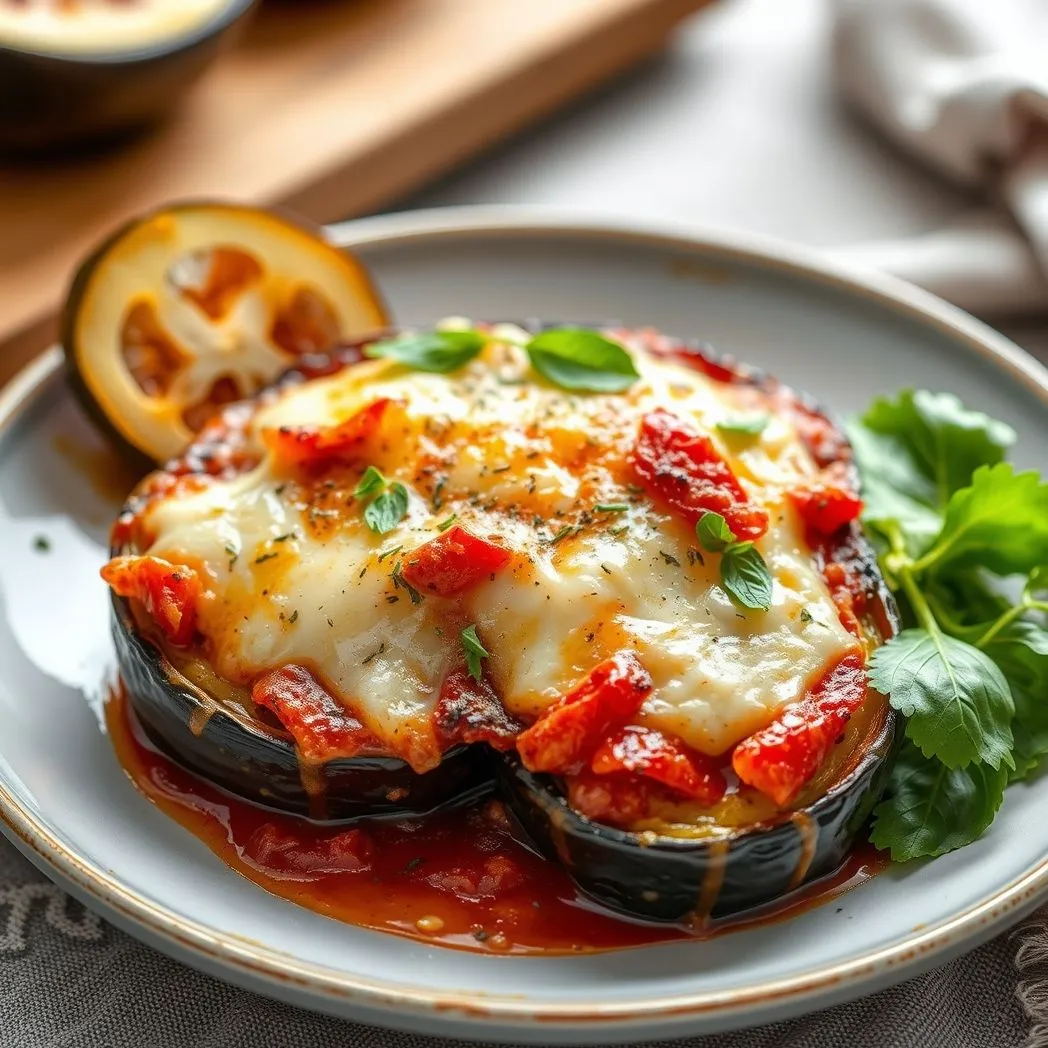Eggplant Parmesan has earned its place as a timeless Italian favorite. With its layers of tender baked eggplant, rich sauce, bubbling cheeses, and aromatic herbs, this dish offers both comfort and sophistication. In this article, I share a comprehensive guide to mastering this baked recipe. You will discover step-by-step instructions, essential tips, and creative ideas to perfect your eggplant parmesan.
Introduction
Eggplant Parmesan is more than a meal. It is a culinary tradition that brings people together around the table. This recipe transforms classic ingredients into a dish that is both hearty and elegant. Whether you serve it as a family dinner or at a casual gathering, the dish invites warm conversation and lasting memories. I crafted this guide to help you not only follow the recipe but also understand the reasons behind each step.
When peppering your kitchen with the aroma of baked eggplant and freshly melted cheese, every bite speaks of authenticity. You will familiarize yourself with semantically related terms like “melanzane” (Italian for eggplant) and explore the rich cultural heritage behind this well-loved recipe.

Ingredients
A good eggplant parmesan starts with the best ingredients. The recipe calls for a handful of base elements:
- Eggplants: Choose vibrant, firm eggplants with smooth skin. Small to medium-sized eggplants work best because they have a delicate flavor.
- Eggs: Fresh eggs help bind the breadcrumbs to the eggplant slices.
- Italian-Seasoned Breadcrumbs: These add a crunchy texture and infuse the dish with herbs.
- Spaghetti Sauce: Use your favorite brand or make your own. A rich, tomato-based sauce is ideal.
- Cheeses: A mix of mozzarella and parmesan creates a creamy, gooey layer. Freshly grated parmesan provides a sharp contrast to the soft mozzarella.
- Dried Basil: For that distinctive Italian aroma and flavor.
- Olive Oil: A drizzle of extra virgin olive oil enhances both flavor and texture during baking.
- Salt and Pepper: To taste, ensuring balanced seasoning.
By sourcing high-quality ingredients, not only do you guarantee great taste, but you also set the foundation for a nutritious meal.
Preparation and Prepping the Eggplant
Before you begin, gather all your ingredients and equipment. Preparation is key for a smooth cooking process.
Steps for Prepping the Eggplant
- Select and Slice: Look for eggplants that are firm and unblemished. Rinse them under cold water and pat dry. Slice the eggplants into 1/2-inch thick rounds. Uniform slices ensure even cooking and crisp results.
- Optional Salting: To reduce moisture, sprinkle each slice lightly with salt. Let them sit for 20–30 minutes, then wipe off the excess salt. This step improves texture by drawing out extra water.
- Set Up Dipping Stations: In one bowl, beat two large eggs. In a separate dish, spread out the Italian-seasoned breadcrumbs. Have your sliced eggplant on a clean tray for easy handling.
These preparatory actions create a controlled kitchen environment. Proper slicing and salting help in achieving an even, non-soggy outcome in the final dish.
Breading the Eggplant
Breading the eggplant is a critical process that creates a delightful crunch once baked. Here is how I approach it:
The Breading Process
- Dip in Egg: Carefully dip each eggplant slice into the bowl of beaten eggs. Ensure each piece is coated.
- Coat with Breadcrumbs: Transfer the egg-coated slices to the breadcrumbs. Press lightly so that the crumbs adhere evenly.
- Arrange on a Baking Sheet: Lay the breaded slices in a single seamless layer on a baking sheet. Avoid overlapping to ensure uniform browning.
The breadcrumb coating not only locks in the moisture but also adds a satisfying texture to each bite. This step is simple yet vital to perfection.
Baking the Eggplant
The baking process transforms raw ingredients into a delicious, layered dish with each stage building upon the previous one.
Initial Bake
- Preheat Your Oven: Set your oven to 350°F (175°C). This moderate temperature gives you control over browning and texture.
- Bake the Eggplant Slices: Place the prepared eggplant slices into the oven for 5 minutes on one side. Flip each slice and bake for an additional 5 minutes. This initial bake firms up the slices so they hold up during layering.
This preliminary baking step reduces excess oil absorption while giving the eggplant a slight crisp. It is a small but essential stage before assembling the dish.
Assembling the Dish
Now comes the creative part: layering the dish to achieve a balanced flavor profile. You can think of each layer as a work of art.
Layering Process
- Prepare the Baking Dish: Start with a light coating of spaghetti sauce on the bottom.
- Arrange an Eggplant Layer: Lay a single layer of your baked eggplant slices in the dish.
- Add the Cheeses: Sprinkle a generous amount of shredded mozzarella and grated parmesan over the eggplant.
- Repeat the Layers: Continue layering by adding another layer of sauce, followed by eggplant and cheeses. Always end with a top layer of cheese to create that desirable golden crust.
- Finish with Basil: Once all layers are set, sprinkle dried basil over the top.
These layers build flavor and texture. The thin, even distribution of sauce ensures that the eggplant remains moist while the cheese melds together with each baking session.
Final Bake and Serving
The final baking step makes all the difference.
Completing the Bake
- Bake Again: Place the assembled dish back into the preheated oven at 350°F. Bake for approximately 35 minutes. You know it’s done when the cheese is bubbly and the edges of the eggplant turn a lovely golden brown.
- Cool Briefly: Remove the dish from the oven and allow it to rest for 5 minutes. This short pause ensures that the layers settle and makes cutting easier.
Serving Suggestions
Eggplant Parmesan shines as a stand-alone dish. However, consider these serving ideas to elevate your meal:
- Fresh Garden Salad: A crisp salad balances the richness.
- Garlicky Breadsticks or Focaccia: Perfect for soaking up any extra sauce.
- Steamed Pasta: A serving of spaghetti or penne pairs well with the Italian flavors.
- Light Soup: A broth-based soup can serve as a refreshing starter to the hearty main course.
Each suggestion complements the dish without overpowering its delicate flavors. Tailor your presentation to match the occasion, whether a casual family dinner or a formal occasion.
Tips and Tricks for Success
Even if you’ve made eggplant parmesan before, a few refined tips elevate your recipe experience. Here are my best tips:
- Use Fresh Eggplant: Fresh eggplant is key. Avoid overly mature or soft eggplants.
- Uniform Slicing: Consistent slice thickness leads to even baking.
- Proper Seasoning: Balance salt and herbs. Taste the sauce first and adjust seasoning as needed.
- Salting Technique: If you choose to salt, do it uniformly. This draws out extra moisture and prevents a soggy base.
- Breadcrumb Variations: Experiment with panko breadcrumbs for an extra crunchy finish. You may also add herbs or garlic powder to the breadcrumbs for a kick.
- Cheese Choice: While mozzarella and parmesan are traditional, you might try provolone or asiago for a different flavor profile.
- Layering Precision: Do not over-sauce. Keep each layer modest to prevent sogginess.
These steps are refined over multiple preparations, ensuring the final dish is as visually appealing as it is delicious.
Variations and Enhancements
Flexibility defines great cooking. Consider these adjustments to personalize the dish:
Alternative Sauces
- Marinara: A robust marinara with garlic, onions, and red pepper flakes adds a zesty twist.
- Homemade Tomato Sauce: Simmer crushed tomatoes with basil, oregano, and garlic. This authentic blend heightens the fresh flavors.
- Creamy Bechamel: For those who love a creamy twist, a light bechamel sauce can replace part of the tomato sauce while retaining a classic taste.
Adding Vegetables
To boost nutritional value, you might include:
- Spinach: Layering fresh spinach between the eggplant slices introduces a slight earthiness.
- Zucchini: Thinly sliced zucchini can add a subtle crunch and complements the tender eggplant.
- Bell Peppers: Roasted red peppers contribute both sweetness and color.
Cheese Alternatives
Experiment with different cheese mixtures. For instance:
- Smoked Mozzarella: Offers a nuanced flavor.
- Fontina or Gouda: Both melt beautifully, contributing to a creamier texture.
Adjust these elements to suit your nutritional needs or personal taste. Customizing a classic recipe ensures it fits your lifestyle perfectly.
Nutritional Benefits
Eggplant Parmesan is not just flavorful—it is also nutritious. Eggplant is low in calories and rich in fiber. The dish provides antioxidants from the tomato sauce and vitamins from the herbs. Cheeses supply calcium and protein, making this a well-rounded meal. Even a generous portion serves up a balanced mix of healthy fats and essential nutrients.
Including vegetables in your eggplant parmesan can raise the dish’s health quotient even further. It is a perfect option for those looking to enjoy indulgence without straying from their nutritional goals.
How to Store and Reheat
Leftovers are a bonus, and proper storage extends the enjoyment of your creation.
Storing Eggplant Parmesan
- Refrigeration: Place cooled eggplant parmesan in an airtight container. It stays fresh for 5 to 7 days. This allows you to enjoy a ready-to-eat meal on busy days.
- Freezing: To freeze, layer the dish in a freezer-safe container, wrap tightly, and date the container. Use within 2 months for best quality.
Reheating Tips
When reheating leftovers, maintain the dish’s integrity:
- Microwave: Heat individual servings on a microwave-safe plate in 1-minute increments. Check to see if the cheese has softened.
- Oven Method: Preheat your oven to 350°F and warm the dish until the cheese bubbles. This method revives the crisp texture.
- From Frozen: For frozen ingredients, allow the dish to thaw completely before baking, or use the oven at 400°F for 15–20 minutes.
These tips help preserve the flavor and texture of the dish, ensuring every bite is as satisfying as the first.
Eggplant Parmesan embodies simplicity and elegance. Each step—from selecting fresh produce to the final bake—requires attention to detail and care. The process invites you to experiment with flavors and create a dish that is uniquely yours.
This recipe is designed to cater to a diverse audience. Whether you are a beginner or a seasoned cook, you will appreciate the clear instructions, supported by useful tips and enhancements. Let the aroma of baked eggplant, simmering tomato sauce, and melting cheese fill your home and hearts.
Enjoy experimenting with this signature dish. Gather your ingredients, follow the structured method, and invite your loved ones to share a true Italian delight. Embrace the art of layering flavors and textures, and soon, eggplant parmesan will become a favorite in your weekly meal plan.
Explore the vibrant culinary tradition behind eggplant parmesan, and let your creativity guide you. Each variation and enhancement leads to a personal masterpiece. Happy cooking, and bon appétit!

Eggplant Parmesan (Baked Recipe)
This classic recipe for eggplant parmesan is baked, not fried. This means you can feel good about it! Learn how to put it together. Plus, get tips for the very best dish.
Ingredients
- 1 (16-ounce) package shredded mozzarella cheese, divided
- 3 large eggplants, peeled and sliced thinly
- 2 large eggs, beaten
- 1/2 cup grated parmesan cheese, divided
- 4 cups Italian-seasoned breadcrumbs
- 6 cups spaghetti sauce, divided
- 1/2 teaspoon dried basil
Instructions
- Preheat the oven to 350 degrees Fahrenheit. Prepare the beaten eggs in one bowl. Prepare the breadcrumbs in a second bowl.
- Place the slices of eggplant into the beaten egg first. Ensure both sides are well-coated. Next, dip the slices into the breadcrumbs. Place the breadcrumb-coated slices on a baking sheet. Don't let them overlap. Don't stack them.
- Bake the eggplant slices at 350 degrees Fahrenheit for 5 minutes. After that, flip them. Continue baking for another 5 minutes.
- Add the spaghetti sauce to the bottom of a 9 x 13 baking dish. Spread it evenly. Make sure to coat the bottom entirely.
- Transfer the eggplant slices to the baking dish. Place them on the sauce in a single layer. Top them with mozzarella and parmesan cheeses. Add a second layer of sauce and eggplant slices. Then, add more cheese and mozzarella. Continue layering in this manner. Finally, end with a layer of cheeses. Top with basil.
- Bake the dish at 350 degrees Fahrenheit for approximately 35 minutes. The cheese should be fully melted. The eggplant slices should be golden brown.
- Remove it from the heat. Allow it to cool for 2-3 minutes. Then, transfer portions to serving plates. Enjoy!




